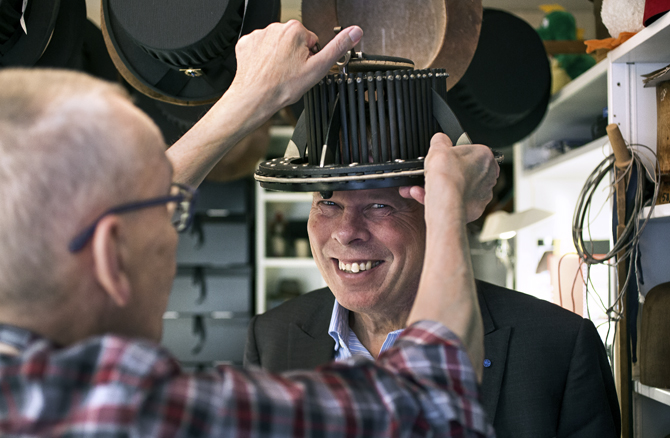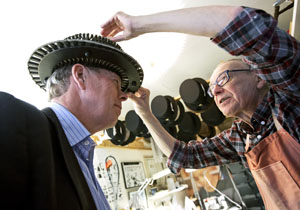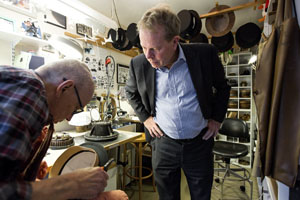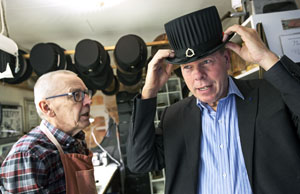
From proteins to promotion
“You have a high forehead, you,” says hat maker Mark Eriksson, as he measures star researcher Mathias Uhléns skull.
“Well, I’ve got a lot of stuff to store in there,” jokes Uhlén, who is getting ready for his role as promoter at KTH’s conferment of doctoral degrees and inauguration of new professors in the Stockholm Concert Hall.
During the drive from SciLifeLab in Solna - where the professor of Microbiology at KTH spends his days - to a hat maker's workshop in Norsborg, we have a chat. Just one day before, Uhlén and his colleagues had presented a decade of work mapping the body’s smallest building blocks - proteins - in an interactive database called the Human Protein Atlas.
It became news worldwide and in the prestigious journal, Science.
“I'm thrilled by the variation in my days - from attending a conference in Beijing with 2,000 scientists one day, to visiting with a hatter in Botkyrka the other,” he says.
The Human Protein Atlas is a unique knowledge base that enhances our understanding of the human being, gives a holistic view of the human body and eventually makes it possible to develop better and more sophisticated medical treatment and diagnosis.

“It's fantastic that we're finished, so to speak, even though the work continues,” he says. “I'd almost be disappointed – or at least very surprised – if the atlas isn’t used for all drug discovery during the next 30 years.”
That life would take such a direction was not on the map when Uhlén began his studies at KTH.
“I did not really know what I wanted when I was done, but on a professor's advice, I landed on genetic engineering in Uppsala,” he says.
The car’s GPS flashes, suggesting that we are approaching.
After a year as a programmer, biotechnology got the upper hand and eventually Uhlén put together a multidisciplinary research team.
“Solving the various problems and difficulties in our amazing team has been among the most fun,” says Uhlén, who notes that he is an optimist by nature.

Distilling the best while letting everyone have their say is something he got used to in his work as director of SciLifeLab, where four different institutions are involved.
“My attitude is if some things are getting gummed up, there are also things that aren’t,” he says, as he retrieves a hat box from the boot of his car.
In the milliner's shop, doctors’ hats hang by side. They are in various stages of perfection and are expected to be operational for various academic pomp and circumstance. The craftsmanship is delicate and a perfect fit is a natural for hatter Eriksson.
Eriksson takes out a tool to measure Uhléns head shape and size. On paper the milliner produces a reduced image of the head which is then converted to the right scale.
Uhlén’s head is in good company. On the wall is a painting with various prominent forms of unique vertices, associated with well-known Swedish actors, Sigge Furst and Allan Edvall.

The task today is to adjust the fit of Uhléns hat slightly, and then replace the insignia for Chalmers University in the front of the hat. The insignia was affixed to the hat when Uhlén received an honorary doctorate from the Gothenburg institution in 2011.
Uhlén is very proud of his mission as a promoter, a role in which he is tasked to welcome and advance this year’s crop of doctorates and honorary doctorates at KTH.
“This is truly an honour from the faculty,” he says.
Eriksson sees that the hat is not really satisfactory without warming up the body of shellac and re-shaping the hat slightly. With the help of a piece of cork, he makes it perfect.
To celebrate the success of one becoming a doctor or being installed as a professor is quite important, says Uhlén, because academic life is no bed of roses.
“Making an academic career is very tough, and you live under constant pressure to perform. So it's really important to take a break and celebrate when you get a chance at these kinds of events,” he says.
He tries on the 13 cm tall, black hat and Eriksson starts to make a correction.
“Give me a break,” Uhlén chides him gently. “You should have it further down. Imagine a pencil width above the eyebrows. That's it. Now, it’s beginning to look like something.”
Jill Klackenberg